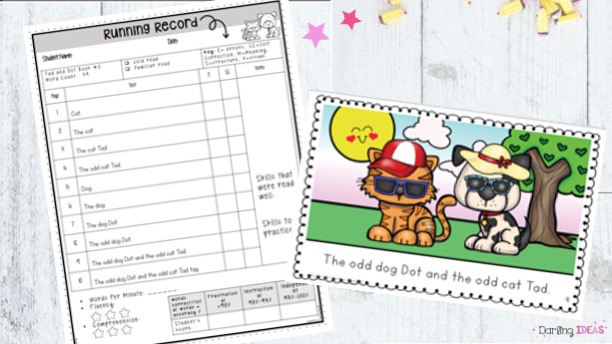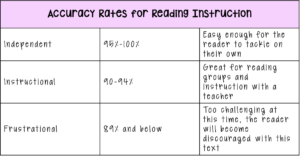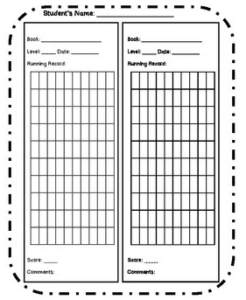So you are moving toward the Science of Reading best practices, phonics instruction is playing a part in daily lessons, phonological awareness is incorporated, and yay! you are using decodable texts too! But, you are still required by your district to perform a running record assessment to measure reading ability. Sometimes, we just have to do what is required of us, but, maybe there are some ways to use that data! This blog post can help.
First, let’s look at what a running record assessment is. Then we can look at how to do one in your classroom, and make the most of that information.

What is a running record assessment?
A running record assessment is very simply when you listen to your students read a text and record any errors they make as they read. Teachers might have a printout of their text or even a paper with boxes to check the words that were read correctly and note any errors. This is a very basic explanation and how-to for doing running record assessments, but I like to keep things simple. 🙂
Running record assessments are a key component in balanced literacy instruction. Teachers who follow the balanced literacy approach use the results of these assessments to determine reading levels and group students into leveled groups. They repeat these assessments and move students up and down in reading levels based on how well they score at a given level. We know that this is not helpful to our students, but some districts are still requiring them.
What will you need for the assessment?
First, you will need your student(s) 🙂 and a decodable text that they have read approximately one time. You will also need a form to record your running record assessment. Ideally, students have read the text once or maybe twice in a small group. You want a text they have seen and gotten the bugs worked out, so to speak, but not a text that they have read often and are super familiar with.
As far as a recording form goes, this can be as fancy as you like. You can use a piece of plain white notebook paper if you have forgotten or just didn’t have time to make a copy of anything else. If you use a plain white piece of paper, you will have to be neat and organized to count the number of words the student read when you are finished. It might be helpful to record ten check marks for correct words or errors on each line of the notebook paper so they are easy to count when finished.
Another option is this form by Ashley Hammet. Click the picture to grab it for free on TPT. This one is pretty basic but most useful. It has one hundred boxes, so you will easily know when students have read 100 words. Each page has space for two records, but if you copy front and back then you can do four running record assessments on one piece of paper.
How do you do the running record assessment?
Listen to your students read and mark their errors. It might be helpful to have a schedule to do a few students each week. Doing the assessment during small groups is good for quick checks and planning for weekly instruction. More about how to use that data for weekly instruction below. Also, if report cards or parent-teacher conferences are coming up, these assessments can be helpful in both of those instances.
Steps for a running record:
- Listen carefully and give a checkmark for each word read correctly.
- Skipped words can be marked with just a dash
- If a word is mispronounced jot down what the student said.
- Make other notes relevant to reteaching and future instruction
Listening to students read approximately one hundred words is plenty of reading to get a good picture of a primary student’s accuracy and fluency as well. After the student is finished reading, subtract the errors from the total number of words read. If they just read 100 words this is my accuracy. For example, 100 words read – 5 errors = 95% accuracy on the text.
If more than 100 words were read, subtract the errors from the total. Divide the number you got when you subtracted by your total number of words for the accuracy percentage. For instance, 123 words read – 9 errors = 114. 114 /123 = 93% accuracy.
Okay, I did the running record assessment, but I am following the Science of Reading. How can I use this data?
One thing you can do is look at the percentage of accuracy. This will help you know if the text your student is reading is too easy, just right for instruction, or too challenging, and frustrating for the reader.
- An independent decodable text is a text a student can pick up and read all by themself. They might miss a word or two, but overall they can read the text and understand it as well.
- An instructional decodable text is one that the students can read, with a little support. This text is perfect for reading groups and instruction. The student can decode most of the words, but they need teacher support and instruction a little bit along the way.
- Frustrational decodable text is just that, it is too challenging for the reader and they become discouraged by the difficulty.

This chart will show you the percentage of accuracy as it relates to the levels mentioned above. There is some discrepancy between different companies and researchers, but this is the most widely used chart. It is really helpful if your small group instruction text falls in the instructional range. If readers score in the frustration level, you may want to look at a simpler text. Likewise, if a reader’s scores fall in the independent range, they may be ready for a more challenging text.
Another great bit of information on your students’ running record assessment is their errors.
You can look at your students’ errors to help you know what skills that they need to work on. For instance, if an analysis of their errors shows they substituted a short i sound for a short e sound, then it would be helpful to plan some small group lessons to work on short i and short e sounds. You get the idea 🙂
What about fluency?
That’s a great question! Fluency is the ability to read with accuracy, expression, and at a rate that supports comprehension too. Hopefully at the independent level students are able to read in phrases with multiple words together as they work up to whole sentences. If they are reading word by word, the text is challenging for them more than likely, but if they are flying through the text it may be too easy. These snapshots are based solely on observation, and you could make note of where your readers’ fluency falls through observation as you do an accuracy check.
If you want to get more technical, you can do that too! To do so, you will need to add a timer to your running record assessments.
- Time students for one minute
- Count the number of words they read in that minute
- Subtract the errors
- Voila! You have the number of words per minute
- Example Number of words read – errors = words per minute
Is the text appropriate for repeated readings?
Repeated readings are pretty self-explanatory. Reading a text more than once can be helpful in building fluency IF students are at least 90% accurate with the text. Running records can help you determine whether or not a decodable text will be an appropriate text for repeated readings.
There are many guidelines and theories on fluency and what is appropriate per grade level and student. We will definitely be exploring these in an upcoming blog post.
I hope this is helpful! I know it can be so frustrating to spend you and your students’ time on something that you may feel is not the best use of that precious time, but I hope that these tips will help a required running record assessment become a little less frustrating and hold more value for you! Please let me know if you have any questions, or if I can help you further!

Want to receive a FREE decodable book from me? Click the book to sign up for my newsletter below! 
Don’t miss out on these freebies from my tpt store!
Decodable Text Mega Bundle in my TPT store
Free Level 1 Passages
Free Level 2 Passages
Free Level 1 Book
Here are some other options that I have used:
- Reading A-Z has a whole library of decodable text. Occasionally, I have difficulty matching it to my readers, but it was still a great resource. They offer a 15-day free trial that would definitely let you try their books out.
- Fly Leaf is offering ALL of their decodable texts for free at the time of this writing (11/23/2020). I like this company as well for students who have mastered consonants, short vowels, and some blends and phonics chunks.






No Comments